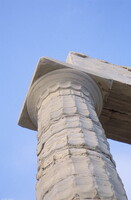Sounion; Temple of Poseidon
unknown (Greek (ancient))

Download1A3-G-S-A11_cp.jpg (365.5Kb)
Alternative Title
Temple of Poseidon at Sounion
Date
-450--440Description
View looking up a Doric column; Site at the furthest south-east point of Attica, about 70 km east of Athens, Greece. The ancient town occupied the headland of Cape Sounion, with its acropolis on a steep promontory, and its most important remains are those of the Sanctuary of Poseidon. The surviving temple dates from around 440 BCE and is one of a series of four temples built to related designs and possibly the work of a single architect. It can be interpreted as a thank-offering for the defeat of the Persians in 480-479 BCE. The temple at Sounion is Doric and peripteral (6 x 13 columns) and was built from marble quarried locally at Agrileza. The columns have only 16 instead of the usual 20 flutings, and the shafts are straight-edged, without the usual slight outward curve (entasis), features that may simply reflect reasons of economy. The porch façade is aligned with the third columns of the flanks, and a continuous Ionic frieze, replacing the normal triglyphs and metopes, extends across the porch and to the back of the outer entablature. Source: Grove Art Online; http://www.groveart.com/ (accessed 1/25/2008)
Type of Work
excavation (site); templeSubject
architectural exteriors, deities, mythology (Classical), Classical
Rights
Rights Statement
Licensed for educational and research use by the MIT community only